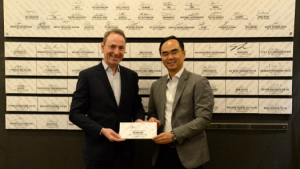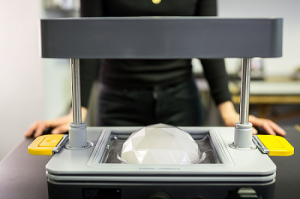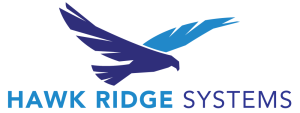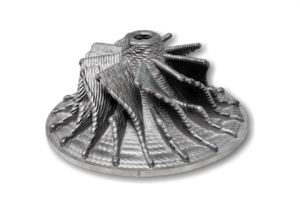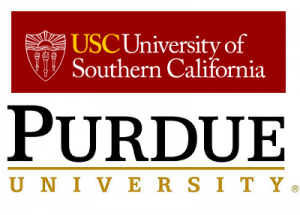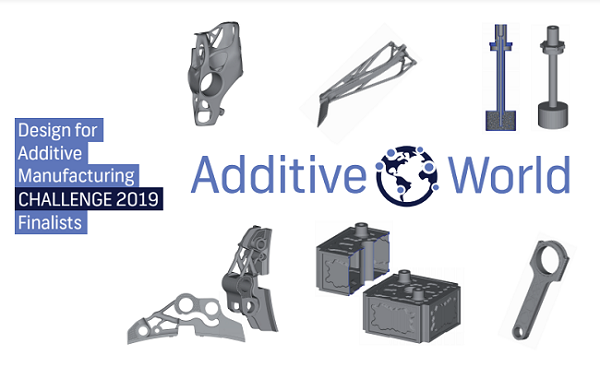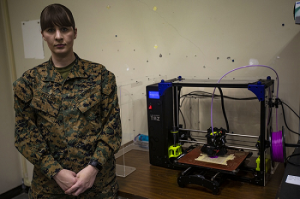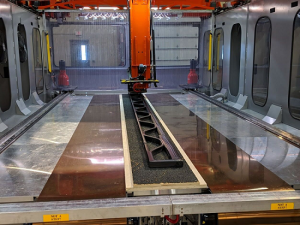We’ve got plenty of business news to share in this week’s 3D Printing News Briefs, but first we’ll start off with something fun – the winners have been announced for this year’s Additive World DfAM Challenge. Moving right along, BeAM is now a Tier 2 member of the ARTC, and PostProcess Technologies has announced improved processing times for SLA resin removal. Protolabs is offering new anodizing services, in addition to teaming up with Wohlers Associates, and Arkema will soon open a new PEKK plant in the US. Continuing with new things, a new AM digital career growth platform just launched, and there’s a new open project call for the European AMable project. Finally, GoPrint3D is the new UK distributor for Mayku and its desktop vacuum casting unit.
Winners Announces for Additive World DfAM Challenge 2019
 This week during an awards dinner at the Additive World Conference in Eindhoven, Ultimaker’s Steven van de Staak, Chairman of the 5-member jury for this year’s Additive Industries’ Design for Additive Manufacturing Challenge, announced the two winners and their “inspiring use cases of industrial 3D metal printing.”
This week during an awards dinner at the Additive World Conference in Eindhoven, Ultimaker’s Steven van de Staak, Chairman of the 5-member jury for this year’s Additive Industries’ Design for Additive Manufacturing Challenge, announced the two winners and their “inspiring use cases of industrial 3D metal printing.”
Obasogie Okpamen from The Landmark University in Nigeria won first place, and an Ultimaker 2+ 3D printer, in the student category for his Twin Spark Engine Connection Rod. While the connection rod that he redesigned for an Alfa Romeo 75 Twin Spark Turbo engine has not yet been fully tested, he won “because of the example it sets” for distributed localized manufacturing of spare parts with 3D printing. Dutch company K3D took home first place, and an Ultimaker 3, in the professional category for the Dough Cutting Knife it developed for Kaak Group, a leader in the bakery equipment world. The team integrated mechanical parts into the design, which can be 3D printed without any support structures and has improved functionality. The knife sits in a dough extrusion line and due to its light weight less knives and robot arms can do the same amount of cutting. This means that the extrusion line itself is cheaper. Furthermore the knife has been optimized for a cleaner cut with less knife sticking to the dough.
BeAM Joins Advanced Remanufacturing and Technology Centre
France-based BeAM, which has subsidiaries in the US and Singapore and was acquired by AddUp this summer, is now partnering with the Advanced Remanufacturing and Technology Centre (ARTC) as a Tier 2 member in an effort to expand its research activities in southeast Asia. The center provides a collaborative platform, which will help BeAM as it continues developing its Directed Energy Deposition (DED) technology with companies from the aerospace, consumer goods, marine, and oil & goods sectors.
This summer, BeAM, which also became a member of the Aachen Centre for Additive Manufacturing earlier this month, will install its Modulo 400, featuring a controlled atmosphere system, at ARTC, so other members can safely develop non-reactive and reactive materials. The two will also work to develop process monitoring systems that can expand DED’s range of applications.
PostProcess Technologies Announces New Solution for SLA Resin Removal
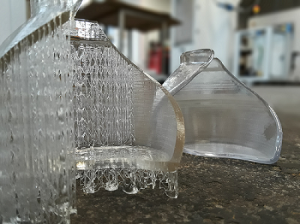 A new and improved solution for SLA resin removal by PostProcess Technologies vastly improves process times by 5-10 minutes – quite possibly the fastest on the market. The system can clean up to five times as many parts before detergent saturation when compared to solvent resin removal, and is part of the company’s automated AM post-print offering. The patent-pending solution, which also reduces environmental hazards and preserves fine feature details, was validated with eight different resin materials in several production environments, and uses the company’s proprietary AUTOMAT3D software and SVC (Submersed Vortex Cavitation) technology in the DEMI and CENTI machines.
A new and improved solution for SLA resin removal by PostProcess Technologies vastly improves process times by 5-10 minutes – quite possibly the fastest on the market. The system can clean up to five times as many parts before detergent saturation when compared to solvent resin removal, and is part of the company’s automated AM post-print offering. The patent-pending solution, which also reduces environmental hazards and preserves fine feature details, was validated with eight different resin materials in several production environments, and uses the company’s proprietary AUTOMAT3D software and SVC (Submersed Vortex Cavitation) technology in the DEMI and CENTI machines.
“PostProcess’ latest innovation of the most advanced SLA resin removal solution in the world reinforces our commitment to providing the AM industry with transformative post- printing solutions enabling the market to scale. SLA is one of the most popular 3D printing technologies in the world. No matter what volume of printing, any SLA user can benefit from the remarkable efficiencies of our solution’s decreased processing time, increased throughput, increased detergent longevity, and improved safety,” said PostProcess Technologies CEO Jeff Mize. “PostProcess has designed the world’s first complete SLA resin removal system, available only from the pioneers in forward-thinking 3D post-printing.”
The new SLA Resin Removal technology will be on display at PostProcess booth P21 at the upcoming AMUG Conference in Chicago. You can also read about it in the company’s new whitepaper.
Protolabs Offering Aluminum Anodizing; Partners with Wohlers Associates
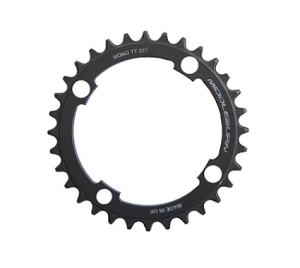 As part of its on-demand production service, digital manufacturer Protolabs is now offering aluminium anodizing in response to demand from customers in need of a single-source solution. Anodizing forms a protective oxide layer by applying a thin, protective coat to the part, which increases abrasion resistance and creates a barrier against corrosion. The company will be offering two levels of this service for Aluminum 6082 and 7075: hard anodizing to ISI 10074 for parts requiring protection from harsh environments, and decorative anodizing to ISO 7599 for parts that need an aesthetic finish. All parts will be sealed, unless they need to be painted post-anodizing.
As part of its on-demand production service, digital manufacturer Protolabs is now offering aluminium anodizing in response to demand from customers in need of a single-source solution. Anodizing forms a protective oxide layer by applying a thin, protective coat to the part, which increases abrasion resistance and creates a barrier against corrosion. The company will be offering two levels of this service for Aluminum 6082 and 7075: hard anodizing to ISI 10074 for parts requiring protection from harsh environments, and decorative anodizing to ISO 7599 for parts that need an aesthetic finish. All parts will be sealed, unless they need to be painted post-anodizing.
“Talking to our clients, we realised that if they needed to anodise an aluminium part it was often difficult for them to source and then manage a supplier. They not only have to do all the research and then raise a separate purchase order, but often find that the supplier only accepts large quantities of parts in an order, which isn’t great for low volume runs,” explained Stephen Dyson, Special Operations Manager at Protolabs.
“Keeping the entire production process with a single supplier makes perfect sense for manufacturers. It means they can get their finished parts shipped in a matter of days and our technical team can advise them through the entire process, right from the initial design of the part to the best approach for the final anodising finish.”
 In other Protolabs news, the company is partnering up with AM consultants Wohlers Associates to jointly hold an immersive course on DfAM. The class, which is invitation-only, will take place over the course of three days near Raleigh, North Carolina, and will end at Protolabs’ 77,000 sq. ft. 3D printing facility. Olaf Diefel, Associate Consultant at Wohlers Associates, and Principle Consultant and President Terry Wohlers will lead the discussion, in addition to being joined by several Protolabs engineers who are skilled in polymer and metal 3D printing.
In other Protolabs news, the company is partnering up with AM consultants Wohlers Associates to jointly hold an immersive course on DfAM. The class, which is invitation-only, will take place over the course of three days near Raleigh, North Carolina, and will end at Protolabs’ 77,000 sq. ft. 3D printing facility. Olaf Diefel, Associate Consultant at Wohlers Associates, and Principle Consultant and President Terry Wohlers will lead the discussion, in addition to being joined by several Protolabs engineers who are skilled in polymer and metal 3D printing.
“Designing for AM offers unique challenges and opportunities not found in traditional design methods. Protolabs brings tremendous depth of expertise and leadership in 3D printing. We’re thrilled to work together to equip attendees with technical skills and manufacturing knowledge needed to unlock the full potential of additive manufacturing,” said Wohlers.
Arkema Opening New PEKK Plant
 Arkema, one of the largest specialty chemical and advanced materials developers, has been busily producing polyetherketoneketone, or PEKK, in France. But this coming Monday, March 24th, it is celebrating its new Kepstan PEKK plant near Mobile, Alabama with a ribbon-cutting ceremony.
Arkema, one of the largest specialty chemical and advanced materials developers, has been busily producing polyetherketoneketone, or PEKK, in France. But this coming Monday, March 24th, it is celebrating its new Kepstan PEKK plant near Mobile, Alabama with a ribbon-cutting ceremony.
The durability and customizable abilities of PEKK make it a good material for a variety of 3D printing purposes. Monday’s event will take place from 10:30 am to 1:30, and will also include VIP comments and lunch. The increased volume of this PEAK material will shake up the high-performance polymer market making PEKK a viable alternative to PEEK and PEI.
New AM Digital Career Growth Platform Launched
 A free interactive platform to help AM professionals enhance their skills and fulfill career opportunities is now launching. i-AMdigital, which counts HP as one of its backing partners, is a joint venture between AM industry recruiter Alexander Daniels Global, digital venture company TES Network, and web and UX design company De Wortel van Drie. The platform was created to develop a growing AM talent pool, and uses smart matching and AI to offer customized career advice, courses, training, and job opportunities.
A free interactive platform to help AM professionals enhance their skills and fulfill career opportunities is now launching. i-AMdigital, which counts HP as one of its backing partners, is a joint venture between AM industry recruiter Alexander Daniels Global, digital venture company TES Network, and web and UX design company De Wortel van Drie. The platform was created to develop a growing AM talent pool, and uses smart matching and AI to offer customized career advice, courses, training, and job opportunities.
“There just isn’t enough talent out there. At the same time the learning and development landscape for additive manufacturing is very fragmented. This makes it difficult for individuals and organisations alike to access courses that can help them upskill. i-AMdigital solves both problems through our digital career growth platform,” said CEO and Co-Founder Nick Pearce of Alexander Daniels Global.
“It is an essential tool for the AM industry that will allow talent to grow their career and make an impact in additive manufacturing. It will provide organisations access to a growing and educated talent force to address their hiring needs and a marketplace for learning and development that can help them upskill their existing workforce in the latest technologies.”
AMable Launches Second Open Project Call
 The AMable project, which receives funding from the European Union Horizon 2020 research and innovation program, has just launched its second project call for proposals and ideas that can be applied to AM. The project is continuing to look for new ways to innovate on services for mid-caps and SMEs in the EU, and chosen teams will receive support from the AMable unit.
The AMable project, which receives funding from the European Union Horizon 2020 research and innovation program, has just launched its second project call for proposals and ideas that can be applied to AM. The project is continuing to look for new ways to innovate on services for mid-caps and SMEs in the EU, and chosen teams will receive support from the AMable unit.
AMable is a Factories of the Future (FoF) project participating in I4MS (ICT for Manufacturing SMEs), and is working to increase adoption of AM technologies through the EU. The project will build a digital model that will provide unbiased access to the best AM knowledge in Europe in an effort to support this adoption. For more details on the call, visit the AMable site.
Express Group Appointed New UK Distributor for Mayku
GoPrint3D, a division of Express Group Ltd, has just been named the new UK distributor for London startup Mayku. The startup created a desktop vacuum casting unit called the FormBox, which is a handy partner for your 3D printer. Once you create a 3D printed mold, you can put it inside the compact FormBox, which is powered by any vacuum cleaner and works with many materials like wax and concrete, to cast a series from it – putting the power of making in your own hands.
“We are thrilled to have partnered with Express Group on our UK and Ireland distribution, building on our existing servicing and repair relationship,” said Alex Smilansky, Mayku Co-Founder and CEO. “When we founded Mayku, our goal was to bring the power of making to as wide an audience as possible. The partnership with Express Group will allow us to deliver a first-class making experience to more people than ever before.”
Discuss these stories and other 3D printing topics at 3DPrintBoard.com or share your thoughts in the Facebook comments below.

